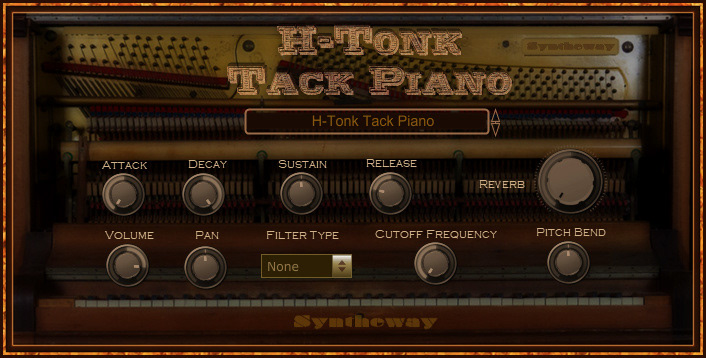H-Tonk Tack Piano VST VST3 Audio Unit: Tack Piano, Western Saloon Piano and Jangle Honky Tonk. EXS24 and KONTAKT Sample Libraries

H-Tonk is a Tack piano that reproduces the altered version of ordinary upright piano with thumb-tacks on the hammers. Suitable for ragtime, vaudeville and Western saloon music as well as unusual honky-tonk pieces. Available as plugin in VST 32 bit and 64 bit and VST3 64 bit versions for Windows as well as in Audio Unit, VST and VST3 for macOS. Also available in EXS24 and KONTAKT Sample Libraries.
Features
• Quick selector to switch between different preset sounds:
1 • Tack Piano (88 keys): A warm, classic altered version of ordinary upright piano (Stereophonic Sampling)
2 • Western Saloon Piano (88 keys): A versatile bright upright piano to evoke a Hollywood Western style (Stereophonic Sampling)
3 • Jangle Honky Tonk Piano (88 keys): A honky tonk piano with an unique and slightly detuned sound (Monophonic Sampling)
• ADSR envelope generator with Attack, Sustain, Decay and Release parameters:
• Attack determines the time it takes for the note to get to the maximum level.
• Decay determines the time it takes for the note to go from the maximum level to the sustain level (controlled by Sustain).
• Sustain determines level the sound is played at while the note is held (after the other envelope states, Attack and Decay, have been completed).
• Release determines the time it takes for the note to fall from the sustain level to zero (silence) level when it is released.
• Attack determines the time it takes for the note to get to the maximum level.
• Decay determines the time it takes for the note to go from the maximum level to the sustain level (controlled by Sustain).
• Sustain determines level the sound is played at while the note is held (after the other envelope states, Attack and Decay, have been completed).
• Release determines the time it takes for the note to fall from the sustain level to zero (silence) level when it is released.
• Pitch Bend: The Pitch Bend knob directly changes the pitch of the selected instrument.
• Pitch Bend center position: is normal pitch.
• Pitch Bend down: Specifies the amount of pitch change that will occur when the pitch bend/modulation lever is moved to the left.
• Pitch Bend up: Specifies the amount of pitch change that will occur when the pitch bend/modulation lever is moved the right.
• Pitch Bend center position: is normal pitch.
• Pitch Bend down: Specifies the amount of pitch change that will occur when the pitch bend/modulation lever is moved to the left.
• Pitch Bend up: Specifies the amount of pitch change that will occur when the pitch bend/modulation lever is moved the right.
• Reverb built-in: provides a spaciousness and depth to simulate the sound reflections from walls, floors and ceilings following a sound created in an acoustically reflective environment. Small rooms can be modeled as well as large spaces.
• Filter Type. Combo box to switch between the following options:
• Low Pass (LPF): a filter that passes signals with a frequency lower than a certain cutoff frequency and attenuates signals with frequencies higher than the cutoff frequency.
• High Pass (HPF): a filter that passes signals with a frequency higher than a certain cutoff frequency and attenuates signals with frequencies lower than the cutoff frequency.
• None: No filter is applied.
• Cutoff Frequency Filter: Sets the cutoff frequency for the low pass and high pass filters.
• Low Pass (LPF): a filter that passes signals with a frequency lower than a certain cutoff frequency and attenuates signals with frequencies higher than the cutoff frequency.
• High Pass (HPF): a filter that passes signals with a frequency higher than a certain cutoff frequency and attenuates signals with frequencies lower than the cutoff frequency.
• None: No filter is applied.
• Cutoff Frequency Filter: Sets the cutoff frequency for the low pass and high pass filters.
• Volume: Adjusts the volume of the instrument.
• Panning potentiometer control: Set the panning of the instrument. Adjusts the stereo pan position of the signal output, which determines how much of signal is sent to the left and right channels.
• MIDI CC Automation: Implementation of MIDI Continuous Controller parameters


